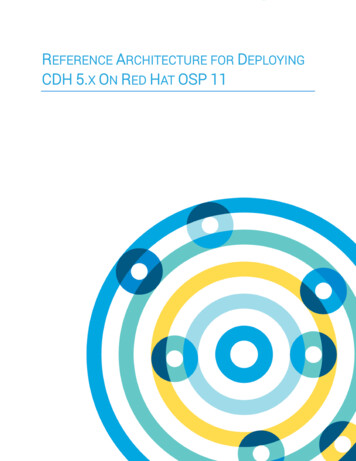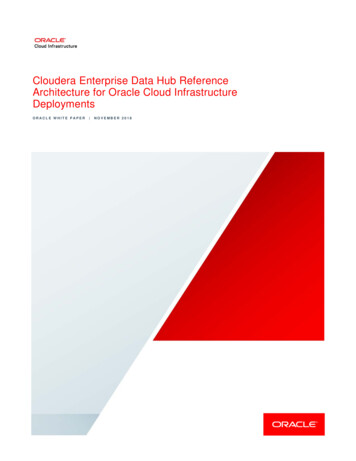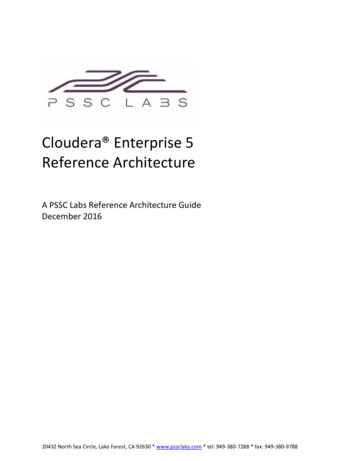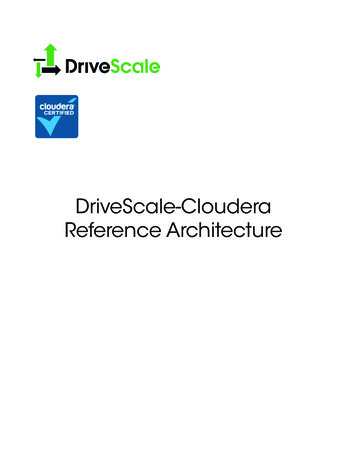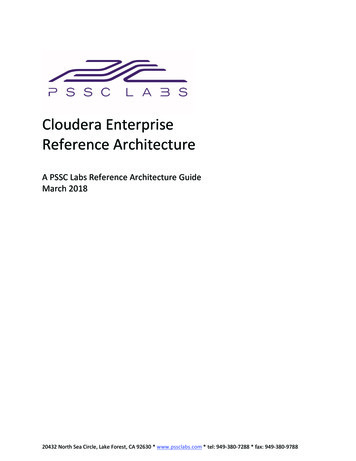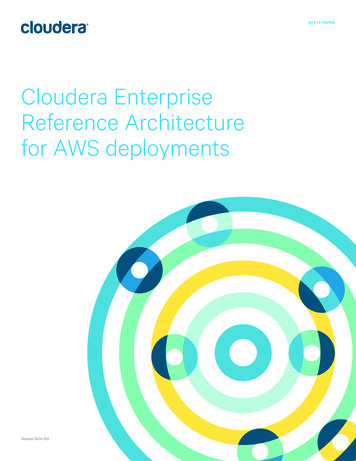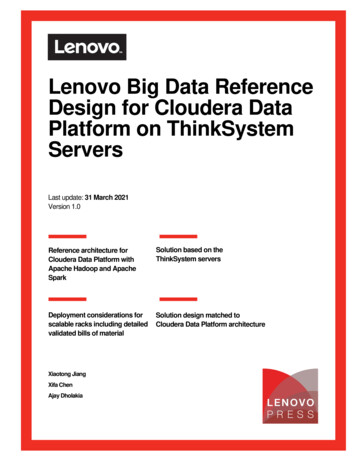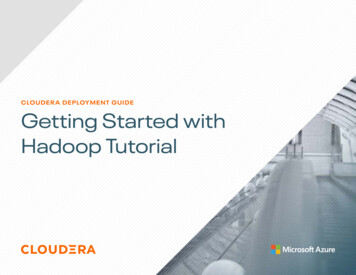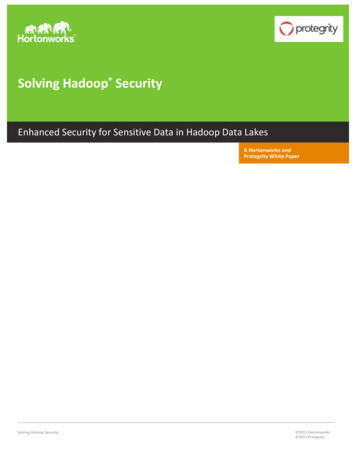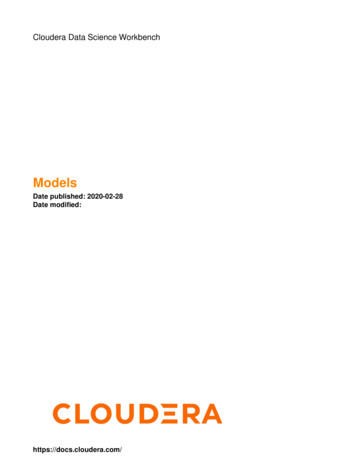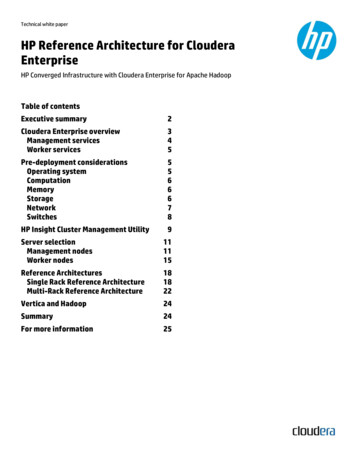
Transcription
Technical white paperHP Reference Architecture for ClouderaEnterpriseHP Converged Infrastructure with Cloudera Enterprise for Apache HadoopTable of contentsExecutive summary2Cloudera Enterprise overviewManagement servicesWorker services345Pre-deployment considerationsOperating 78HP Insight Cluster Management Utility9Server selectionManagement nodesWorker nodes111115Reference ArchitecturesSingle Rack Reference ArchitectureMulti-Rack Reference Architecture181822Vertica and Hadoop24Summary24For more information25
Executive summaryHP and Apache Hadoop allow you to derive new business insights from Big Data by providing a platform to store,manage and process data at scale. However, Apache Hadoop is complex to deploy, configure, manage and monitor. Thiswhite paper provides several performance optimized configurations for deploying Cloudera Enterprise clusters ofvarying sizes on HP infrastructure that provide a significant reduction in complexity and increase in value andperformance.The configurations are based on Cloudera’s Distribution including Apache Hadoop (CDH), specifically CDH3u3, ClouderaManager 3.7 and the HP ProLiant DL Gen8 server platform. The configurations reflected in this document have beenjointly designed and developed by HP and Cloudera to provide optimum computational performance for Hadoop and arealso compatible with CDH4 upon its release.HP Big Data solutions provide best-in-class performance and availability, with integrated software, services,infrastructure, and management – all delivered as one proven solution as described at hp.com/go/hadoop. In addition tothe benefits described above, the solution in this white paper also includes the following features that are unique to HP: For Vertica, the Vertica connectors for Hadoop allow seamless integration of both structured and unstructured dataproviding end-to-end analytics thereby simplifying bi-directional data movement for Hadoop and reducing customerintegration costs. Vertica is a leading real-time, scalable, analytical platform for structured data. For networking, the HP 5830AF-48G 1GbE Top of Rack switch and the HP 5920AF-24XG 10GbE Aggregation switchprovide IRF Bonding and sFlow which simplifies the management, monitoring and resiliency of the customer’s Hadoopnetwork. In addition, the 1GB and 3.6GB respective packet buffers increase Hadoop network performance byseamlessly handling burst scenarios such as Shuffle, Sort and Block Replication which are common in a Hadoopnetwork. For servers, the HP ProLiant Gen8 DL360p and DL380p include:– The HP Smart Array P420i controller which provides increased1 I/O throughput performance resulting in asignificant performance increase for I/O bound Hadoop workloads (a common use case) and the flexibility for thecustomer to choose the desired amount of resilience in the Hadoop Cluster with either JBOD or various RAIDconfigurations.– Two sockets with the fastest 6 core processors and the Intel C600 Series Chipset, providing the performancerequired for fastest time to completion for CPU bound Hadoop workloads.– The HP FlexibleLOM network technologies provide customers the flexibility to easily move between 1GbE and10GbE network interconnects on the server.– The HP iLO Management Engine on the servers contains HP Integrated Lights-Out 4 (iLO 4) which features acomplete set of embedded management features for HP Power/Cooling, Agentless Management, Active HealthSystem, and Intelligent Provisioning which reduces node and cluster level administration costs for Hadoop. For management, HP Insight Cluster Management Utility (CMU) provides push-button scale out and provisioning withindustry leading provisioning performance (deployment of 800 nodes in 30 minutes), reducing deployments fromdays to hours. In addition, CMU provides real-time and historical infrastructure and Hadoop monitoring with 3Dvisualizations allowing customers to easily characterize Hadoop workloads and cluster performance reducingcomplexity and improving system optimization leading to improved performance and reduced cost. HP InsightManagement and HP Service Pack for ProLiant, allow for easy management of firmware and the server.All of these features reflect HP’s balanced building blocks of servers, storage and networking, along with integratedmanagement software and bundled support.In addition, this white paper has been created to assist in the rapid design and deployment of Cloudera Enterprisesoftware on HP infrastructure for clusters of various sizes. It is also intended to concretely identify the software andhardware components required in a solution in order to simplify the procurement process. The recommended HPSoftware, HP ProLiant servers, and HP Networking switches and their respective configurations have been carefullytested with a variety of I/O, CPU, network, and memory bound workloads. The configurations included provide the bestvalue for optimum MapReduce and HBase computational performance, resulting in a 3x performance advantage overthe closest competition2.Target audience: This document is intended for decision makers, system and solution architects, system administratorsand experienced users who are interested in reducing the time to design or purchase an HP and Cloudera solution. An12Compared to the previous generation of Smart Array controllershttp://www.hp.com/hpinfo/newsroom/press kits/2012/HPDiscover2012/Hadoop Appliance Fact Sheet.pdf2
intermediate knowledge of Apache Hadoop and scale out infrastructure is recommended. Those already possessingexpert knowledge about these topics may proceed directly to Pre-deployment considerations on page 5.Cloudera Enterprise overviewApache Hadoop is an open-source project administered by the Apache Software Foundation. Hadoop’s contributors workfor some of the world’s biggest technology companies. That diverse, motivated community has produced a genuinelyinnovative platform for consolidating, combining and understanding large-scale data in order to better comprehend thedata deluge. Enterprises today collect and generate more data than ever before. Relational and data warehouseproducts excel at OLAP and OLTP workloads over structured data. Hadoop, however, was designed to solve a differentproblem: the fast, reliable analysis of both structured data and complex data. As a result, many enterprises deployHadoop alongside their legacy IT systems, which allows them to combine old data and new data sets in powerful newways.Technically, Hadoop consists of two key services: reliable data storage using the Hadoop Distributed File System (HDFS)and high-performance parallel data processing using a technique called MapReduce. Hadoop runs on a collection ofcommodity, shared-nothing servers. You can add or remove servers in a Hadoop cluster at will; the system detects andcompensates for hardware or system problems on any server. Hadoop, in other words, is self-healing. It can deliver data– and can run large-scale, high-performance processing jobs – in spite of system changes or failures. Originallydeveloped and employed by dominant web companies like Yahoo and Facebook, Hadoop is now widely used in finance,technology, telecom, media and entertainment, government, research institutions and other markets with significantdata. With Hadoop, enterprises can easily explore complex data using custom analyses tailored to their information andquestions.Cloudera is an active contributor to the Hadoop project and provides an enterprise-ready, 100% open source distributionthat includes Hadoop and related projects. Cloudera’s distribution bundles the innovative work of a global open-sourcecommunity; this includes critical bug fixes and important new features from the public development repository andapplies all this to a stable version of the source code. In short, Cloudera integrates the most popular projects related toHadoop into a single package, which is run through a suite of rigorous tests to ensure reliability during production. Inaddition, Cloudera Enterprise is a subscription offering which enables data-driven enterprises to run Apache Hadoopenvironments in production cost effectively with repeatable success. Comprised of Cloudera Support and ClouderaManager, a software layer that delivers deep visibility into and across Hadoop clusters, Cloudera Enterprise givesHadoop operators an efficient way to precisely provision and manage cluster resources. It also allows IT shops to applyfamiliar business metrics – such as measurable SLAs and chargebacks – to Hadoop environments so they can run atoptimal utilization. Built-in predictive capabilities anticipate shifts in the Hadoop infrastructure, ensuring reliableoperation.Cloudera Enterprise makes it easy to run open source Hadoop in production: Simplify and accelerate Hadoop deployment Reduce the costs and risks of adopting Hadoop in production Reliably operate Hadoop in production with repeatable success Apply SLAs to Hadoop Increase control over Hadoop cluster provisioning and managementFor detailed information on Cloudera Enterprise, please see cloudera.com/products-services/enterprise/3
Figure 1. Cloudera EnterpriseTypically, Hadoop clusters are either used for batch MapReduce analysis of data or they are used to run HBase, which isan online distributed store for reading and writing structured data. It is up to the user to choose which services to installand configure. We recommend that you run either MapReduce or HBase on your worker nodes as running both themaster (JobTracker and HBaseMaster) and worker services (TaskTracker and HBaseRegionServer) will result in bothservices competing for the same resources, thereby resulting in degraded performance.The platform functions within Cloudera Enterprise are provided by two key groups of services, namely the Managementand Worker Services. Management Services manage the cluster and coordinate the jobs whereas Worker Services areresponsible for the actual execution of work on the individual scale out nodes. The two tables below specify whichservices are management services and which services are workers services. Each table contains two columns. The firstcolumn is the description of the service and the second column specifies the number of nodes the service can bedistributed to. The Reference Architectures (RAs) we provide in this document will map the Management and WorkerServices onto HP infrastructure for clusters of varying sizes. The RAs factor in the scalability requirements for eachservice so this is not something you will need to manage.Management servicesTable 1. Cloudera Management ServicesServiceMaximum Distribution across NodesCloudera Manager1Hue Server1JobTracker1HBase MasterVariesNameNode1Secondary NameNode14
Worker servicesTable 2. Cloudera Enterprise Worker ServicesServiceMaximum Distribution across NodesDataNodeMost or all nodesTaskTrackerMost or all nodesHBase RegionServerVariesPre-deployment considerationsThere are a number of key factors you should consider prior to designing and deploying a Hadoop Cluster. The followingsubsections articulate the design decisions in creating the baseline configurations for the reference architectures. Therationale provided includes the necessary information for you to take the configurations and modify them to suite aparticular custom scenario.Functional ComponentValueOperating SystemImproves Availability and ReliabilityComputationAbility to balance Price with PerformanceMemoryAbility to balance Price with Capacity and PerformanceStorageAbility to balance Price with Capacity and PerformanceNetworkAbility to balance Price with PerformanceOperating systemCloudera Manager 3.7 supports only the following 64-bit operating systems: For Red Hat systems, Cloudera provides 64-bit packages for Red Hat Enterprise Linux 5 and Red Hat Enterprise Linux6. Cloudera recommends using update 5 or later for Red Hat Enterprise Linux 5. For SUSE systems, Cloudera provides 64-bit packages for SUSE Linux Enterprise Server 11 (SLES 11). Service pack 1 orlater is required.CDH3u3 supports the following 32-bit and 64-bit operating systems: For Ubuntu systems, Cloudera provides 32-bit and 64-bit packages for Lucid (10.04) and Maverick (10.10). For Debian systems, Cloudera provides 32-bit and 64-bit packages for Squeeze (6.0.2) and Lenny (5.0.8). For Red Hat systems, Cloudera provides 32-bit and 64-bit packages for Red Hat Enterprise Linux 5 and CentOS 5, and64-bit packages for Red Hat Enterprise Linux 6 and CentOS 6. Cloudera recommends using update 5 or later of RedHat Enterprise Linux 5. For SUSE systems, Cloudera provides 64-bit packages for SUSE Linux Enterprise Server 11 (SLES 11). Service pack 1 orlater is required.5
HP recommends using a 64-bit operating system to avoid constraining the amount of memory that can be used onworker nodes. 64-bit Red Hat Enterprise Linux 5.5 update 5 or greater is recommended due to better ecosystemsupport, more comprehensive functionality for components such as RAID controllers and compatibility with HP InsightCMU. The Reference Architectures listed in this document were tested with 64-bit Red Hat Enterprise Linux 6.2.ComputationMapReduce slots are configured on a per server basis and are decided upon via an examination of the resourcesavailable on the server and how they can cater to the requirements of the tasks involved in a Hadoop Job. Theprocessing or computational capacity of a Hadoop cluster is determined by the aggregate number of MapReduce slotsavailable across all the worker nodes. Employing Hyper-Threading increases your effective core count, potentiallyallowing you to configure more MapReduce slots. Refer to the Storage section below to see how I/O performance issuesarise from sub-optimal disk to core ratios (too many slots and too few disks).To remove the bottleneck for CPU bound workloads, for the best cost/performance tradeoff, we recommend buying 6core processors with faster clock speeds as opposed to buying 8 core processors.MemoryUse of Error Correcting Memory (ECC) is a practical requirement for Apache Hadoop and is standard on all HP ProLiantservers. Memory requirements differ between the management nodes and the worker nodes. The management nodestypically run one or more memory intensive management processes and therefore have higher memory requirements.Worker nodes need sufficient memory to manage the TaskTracker and DataNode processes in addition to the sum of allthe memory assigned to each of the MapReduce slots. If you have a memory bound MapReduce job we recommend thatyou increase the amount of memory on all the worker nodes. In addition, the cluster can also be used for HBase which isvery memory intensive.It is important to saturate all the memory channels available to ensure optimal use of the memory bandwidth. Forexample, on a two socket processor with eight memory channels available per server one would typically fully populatethe channels with either 4GB DIMMs or 8GB DIMMs resulting in a configuration of 32GB or 64GB of memory per server,respectively.StorageFundamentally, Hadoop is designed to achieve performance and scalability by moving the compute activity to the data.It does this by distributing the Hadoop job to worker nodes close to their data, ideally running the tasks against data onlocal disks.Given the architecture of Hadoop, the data storage requirements for the worker nodes are best met by direct attachedstorage (DAS) in a Just a Bunch of Disks (JBOD) configuration and not as DAS with RAID or Network Attached Storage(NAS).6
There are several factors to consider and balance when determining the number of disks a Hadoop worker noderequires. Storage capacity – The number of disks and their corresponding storage capacity determines the total amount of theHDFS storage capacity for your cluster. Redundancy – Hadoop ensures that a certain number of block copies are consistently available. This number isconfigurable in the block replication factor setting, which is typically set to three. If a Hadoop worker node goes down,Hadoop will replicate the blocks that had been on that server onto other servers in the cluster to maintain theconsistency of the number of block copies. For example, if the NIC (Network Interface Card) on a server with 16 TB ofblock data fails, 16 TB of block data will be replicated between other servers in the cluster to ensure the appropriateamount of replicas exist. Furthermore, the failure of a non-redundant TOR (Top of Rack) switch will generate evenmore replication traffic. One needs to ensure that the performance of the network is sufficient to adequately handleMapReduce shuffle and sort phases occurring at the same time as block replication. I/O performance – Each worker node has a certain number of MapReduce slots available for processing Hadoop tasks.Each slot operates on one block of data at a time. The more disks you have, the less likely it is that you will havemultiple tasks accessing a given disk at the same time. This avoids queued I/O requests and incurring the resulting I/Operformance degradation. Disk Configuration – The management nodes are configured differently from the worker nodes because themanagement processes are generally not redundant and as scalable as the worker processes. For managementnodes, storage reliability is therefore important and SAS drives are recommended. For worker nodes, one has thechoice of SAS or SATA and as with any component there is a cost/performance tradeoff. If performance and reliabilityare important, we recommend SAS MDL disks otherwise we recommend SATA disks. Specific details around disk andRAID configurations will be provided in the Server selection section.NetworkConfiguring a single Top of Rack (TOR) switch per rack introduces a single point of failure for each rack. In a multi-racksystem such a failure will result in a flood of network traffic as Hadoop rebalances storage, and in a single-rack systemsuch a failure brings down the whole cluster. Consequently, configuring two TOR switches per rack is recommended forall production configurations.Hadoop is rack-aware and tries to limit the amount of network traffic between racks. The bandwidth and latencyprovided by a 1 Gigabit Ethernet (GbE) connection from worker nodes to the TOR switch is adequate for most Hadoopconfigurations. Multi-Rack Hadoop clusters, that are not using IRF bonding for inter-rack traffic, will benefit from havingTOR switches connected by 10 GbE uplinks to core aggregation switches. Large Hadoop clusters introduce multipleissues that are not typically present in small to medium sized clusters. To understand the reasons for this, it is helpful toreview the network activity associated with running Hadoop jobs and with exception events such as server failure.During the map phase of Hadoop jobs that utilize the HDFS, the majority of tasks reference data on the server thatexecutes the task (node-local). For those tasks that must access data remotely, the data is usually on other servers inthe same rack (rack-local). Only a small percentage of tasks need to access data from remote racks. Although theamount of remote-rack accesses increases for larger clusters, it is expected to put a relatively small load on the TOR andcore switches.During the shuffle phase, the intermediate data has to be pulled by the reduce tasks from mapper output files across thecluster. While network load can be reduced if partitioners and combiners are used, it is possible that the shuffle phasewill place the core and TOR switches under a large traffic load. Consequently, large clusters will benefit from having TORswitches with packet buffering and connected by 10 GbE uplinks to core aggregation switches in order to accommodatethis load.Each reduce task can concurrently request data from a default of five mapper output files. Thus, there is the possibilitythat servers will deliver more data than their netw
Multi-Rack Reference Architecture 22 Vertica and Hadoop 24 Summary 24 For more information 25. 2 . Cloudera is an active contributor to the Hadoop project and provides an enterprise-ready, 100% open source distribution that includes Hadoop and related projects. Cloudera’s distrib
